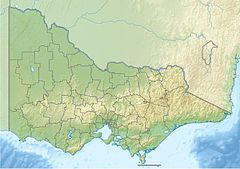The Timbarra River is a perennial river of the Mitchell River catchment, located in the East Gippsland region of the Australian state of Victoria.[3]
| Timbarra | |
|---|---|
| Location | |
| Country | Australia |
| State | Victoria |
| Region | South East Corner (IBRA), Victorian Alps, East Gippsland |
| Local government area | Shire of East Gippsland |
| Physical characteristics | |
| Source | Nunniong Plains, Great Dividing Range |
| • location | below Blue Shirt Hill, Victorian Alps |
| • coordinates | 37°7′40″S 147°59′47″E / 37.12778°S 147.99639°E |
| • elevation | 1,260 m (4,130 ft) |
| Mouth | confluence with the Tambo River |
• location | southeast of Tambo Crossing |
• coordinates | 37°33′57″S 147°58′13″E / 37.56583°S 147.97028°E |
• elevation | 88 m (289 ft) |
| Length | 90 km (56 mi) |
| Basin features | |
| River system | Mitchell River catchment |
| Tributaries | |
| • right | Back River (Victoria), Wilkinson Creek, Cutts Creek, Mount Elizabeth Creek |
| [1][2] | |
Course and features
editThe Timbarra River rises on the Nunniong Plains, below Blue Shirt Hill, that is part of the Victorian Alps of the Great Dividing Range; approximately 30 kilometres (19 mi) east of Omeo.[3] The river flows through the Nunniong Plain and the Mount Elizabeth scenic reserves; generally south, then east, then south, then south by east, then southwest, joined by the Back River and three minor tributaries, before reaching its confluence with the Tambo River about 10 kilometres (6.2 mi) southeast of Tambo Crossing in the Shire of East Gippsland.[4][5] The river descends 1,170 metres (3,840 ft) over its 90-kilometre (56 mi) course;[2] much of which is through forested mountain areas and steep gorges, with a bed of gravel, boulders and mud and numerous pools.[6] Along its route it passes through the small settlement of Timbarra, about 30 kilometres (19 mi) northwest of Buchan.[4]
Together with the Nicholson, Tambo, and Mitchell rivers, and their respective drainage basins, including the Timbarra River, the rivers empty into the Gippsland Lakes and flow into Bass Strait.[2][3][4][7]
The isolated Timbarra River Gorge, 8 kilometres (5.0 mi) north of Timbarra, has been classified as a site of local significance by the Geological Society of Australia.[8]
Ecology and recreation
editThe Timbarra River is in good environmental condition, and maintains a reliable year-round flow.[5][9]
Although access to the river is difficult, it remains popular for fishing, especially for the introduced brown trout which spawn naturally in the river without the need for artificial stocking.[6] Native fish found in the river include the vulnerable Australian grayling, the river blackfish, tupong, and eels.[6]
The Swifts Creek School has named one of its sports houses Timbara, after the river.[10]
See also
editReferences
edit- ^ "Timbarra River: 27786". Vicnames. Government of Victoria. 2 May 1966. Archived from the original on 14 January 2014. Retrieved 13 January 2014.
- ^ a b c "Map of Timbarra River, VIC". Bonzle Digital Atlas of Australia. Retrieved 13 January 2014.
- ^ a b c 8423 Omeo, Victoria, Topographic Map (Map) (1 ed.). National Topographic Map Series. Commonwealth of Australia. 1982.
- ^ a b c Vicroads Country Street Directory of Victoria (4 ed.). Noble Park, Victoria: Royal Automobile Club of Victoria. 2000. ISSN 1329-5284.
- ^ a b "Timbarra River – Tambo Nicholson Catchment". East Gippsland Directories. G.W. & L.A. Keating. Retrieved 21 May 2009.
- ^ a b c "Tambo River Basin – Angling Waters: Timbarra River, Timbarra". Department of Primary Industries Official Website. Government of Victoria. 1996–2012. Retrieved 30 December 2012.
- ^ Nicholson/Tambo Map (Map). East Gippsland Catchment Management Authority. Archived from the original on 12 September 2009. Retrieved 21 May 2009.
- ^ "Victorian Resources Online: 8523-6 Timbarra River Gorge". Victorian Resources Online: Department of Primary Industries. Government of Victoria. 1996–2009. Retrieved 22 May 2009.
- ^ "Tambo River Basin". Department of Primary Industries. Government of Victoria. 1996–2012. Retrieved 30 December 2012.
- ^ "Swifts Creek Secondary College – About: Sport". Swifts Creek P-12 School. 2009. Retrieved 30 December 2012.
External links
edit- "Tambo River sub-catchment". East Gippsland Catchment Management Authority. Government of Victoria.
- "Tambo River – Catchment Map" (map). East Gippsland Catchment Management Authority. Government of Victoria.
- East Gippsland Catchment Management Authority (2013). East Gippsland regional catchment strategy 2013 -2019 (PDF). Bairnsdale: East Gippsland Catchment Management Authority. ISBN 978-0-9758164-6-2.
